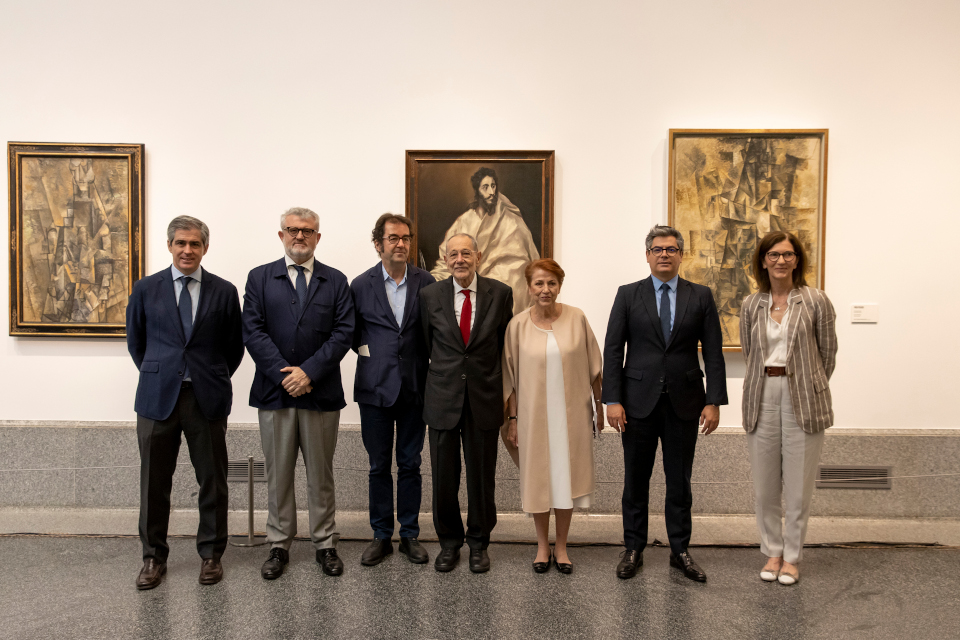Museo Nacional del Prado
Until September 17, room 9B of the Villanueva building houses the exhibition "Picasso, El Greco and Analytical Cubism", an exhibition that, sponsored by the Friends of the Prado Museum Foundation and with the collaboration of the Community of Madrid, focuses in the cubist work of Picasso and the late work of El Greco.
Although almost all the authors agree in limiting the influence of El Greco almost exclusively to Picasso's youth, this exhibition suggests that it was much more profound and lasting, since it was especially crucial for the development of Cubism and, in particular, for the period Analytical Cubism, in works such as El aficionado or Accordionista .
In this room are also testimonial documents that highlight Picasso's particular vital and artistic link with the Prado Museum, a relationship that began in his years as a copyist and ended with his appointment as director.
With the opening of this exhibition, the number of temporary exhibitions that can be visited at the Prado Museum rises to six, a figure never reached to date: “Guido Reni”, “Herrera 'el Mozo' and the total Baroque” and “Emilio Sanchez Perrier (1855-1907). Drawings” in the Jerónimos building, and “Portraits of Sorolla” and “Spanish Masterpieces from the Frick Collection” together with the itinerary “Calderón and painting” in the Villanueva building.

Image of the presentation of the exhibition. Photo © Museo Nacional del Prado
Registered in La Celebración Picasso 1973-2023, an exhibition program that commemorates the fiftieth anniversary of the death of the Spanish artist and that has the collaboration of Telefónica in Spain, the exhibition "Picasso, El Greco and Analytical Cubism", curated by Carmen Giménez, shows the most radical correlation between these two artists to reflect on a fundamental aspect: the ascendancy of the Cretan over the Malaga when he entered cubism. This exhibition offers the opportunity to understand the relationship between the two artists, two original sensibilities that speak of the redefinition of the artistic fact through volume and color, composition and perspective, space and light, and the challenge of dogma. academic and classical tradition.
Among the many and very diverse influences of other masters that come together in Picasso's work, that of El Greco is perhaps the earliest and most decisive, since it began at the end of the 19th century, when the man from Malaga, almost a teenager, lived in Madrid and He is a student at the San Fernando Royal Academy of Fine Arts. From his letters and drawings from that formative period, it is known that he spent more time in the Museo del Prado copying the great masters than in the Academy itself. 'El Greco, Velázquez, inspire me', can be read in a drawing from those years. 'I, El Greco' he wrote down in another drawing. Quite a declaration of intent for a young student barely seventeen years old, sensing in El Greco's work the germ of what he would precisely have to rid modern painting of. El Greco at that time was not a value.
It is true that El Greco enjoyed a certain fame from the time he settled in Spain in 1577 until his death in 1614, but ever since he died, a local legend has been woven about the crazy distortion of his pictorial style in his last years that ended up obscuring subsequently his critical reputation. It was not until almost the end of the 19th century that he began to claim it, thanks to the young European avant-garde of this period. El Greco took three centuries to be understood, but once recovered from oblivion, he provided Picasso with the keys to definitively break with the art of the past and the pillars of traditional representation.
In the abundant artistic literature written on Picasso, almost all the authors insist on the evidence of the link between El Greco and the artist from Malaga, but almost all agree that this influence was almost exclusively during his youth, not only because of his notebooks from period between Madrid, Barcelona and Paris, but considering that it was crucial for the so-called "blue period". However, this influence was much deeper and more lasting and was especially crucial to the development of Cubism and, in particular, to the phase of Analytical Cubism, with its flattening of perspective and vertical format. A confrontation of the respective works of both artists focusing on the cubist work of Picasso and the late work of El Greco, in the direct format that allows an exhibition, opens new perspectives,